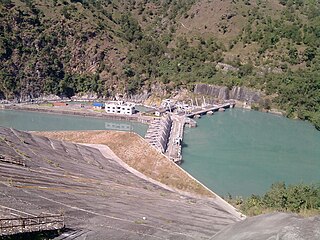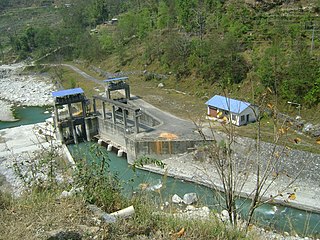Bidur is the capital of Nuwakot District in Bagmati Province, Nepal. At the time of the 1991 Nepal census it had a population of 18694 and had 3736 houses in it.

Kaligandaki A Hydroelectric Power Station is situated near Mirmi of Syangja District about 300 km to the west of Kathmandu and 100 km from Pokhara in the same direction in Nepal. The hydropower project is also the biggest hydropower project of Nepal. The dam and headworks are situated on the Gandaki River at the confluence of the Andhikhola whereas the power house is located downstream, around a bend in the river, in Beltari. A 5.9 km (3.7 mi) long headrace tunnel connects the reservoir to the power station which contains three 48 MW Francis turbine-generators. Owner and operator of the power plant is Nepal Electricity Authority.

Renewable energy in Nepal is a sector that is rapidly developing in Nepal. While Nepal mainly relies on burning biomass for its energy needs, solar and wind power is being seen as an important supplement to solve its energy crisis. The most common form of renewable energy in Nepal is hydroelectricity.
Devighat is one of the historical and religious place of Nuwakot District of Central development region in Nepal. It is located at 60 km north of Kathmandu. It is the death place and place of funeral of king Prithvi Narayan Shah.
Nepal Electricity Authority (NEA), founded on 16 August 1985, is the parent generator and distributor of electric power under the supervision of the government of Nepal.

The Kulekhani Dam is a rock-fill dam on the Kulekhani River near Kulekhani in Makwanpur District of Narayani Zone, Nepal. The primary purpose of the dam is hydroelectric power generation and it supports the 60 MW Kulekhani I and 32 MW Kulekhani II Hydropower Stations. Construction began in 1977 and Kulekhani I was commissioned in 1982. Kulekhani II was commissioned in 1986 and a third power station, the 14 MW Kulekhani III was expected to be commissioned in May 2015 but was delayed due to issues with the builder. The US$117.84 million project received funding from the World Bank, Kuwait Fund, UNDP, Overseas Economic Cooperation Fund and OPEC Fund. It is owned by Nepal Electricity Authority.

The Upper Tamakoshi Hydroelectric Project is a 456 MW peaking run-of-the-river hydroelectric project in Nepal. It is the largest hydroelectric project in Nepal, operating since July 2021. It is sited on the Tamakoshi River, a tributary of the Sun Kosi river, near the Nepal–Tibet border.
The Budhi Gandaki Hydroelectric Project is a proposed hydroelectric power plant in Nepal, to be developed by Nepal Electricity Authority (NEA).
Vietnam exploits all four big sources of renewable energy: hydroelectricity, wind power, solar power and biomass. The potential for hydroelectricity is well developed. By the end of 2018, hydropower was the largest source of renewable energy, contributing about 40% to the total national electricity capacity.

Trishuli Hydropower Station is a peaking run-of-river hydropower station located at Trishuli bazaar of Nuwakot district in Nepal. The intake of the plant lies in Rasuwa district. The plant was constructed in 1976 with an installed capacity of 21 MW. The plant was overhauled in 1995 and upgraded to 24 MW. The project was developed jointly by the Government of India and the Government of Nepal. The project cost was INR 140 million. The annual energy generation is 163 GWh.Nepal Electricity Authority, a government-run organization, owns and operates this plant. Another power station Devighat Hydropower Station is a cascade project to this power station.
The Independent Power Producers Association Nepal (IPPAN) is an association of private developers and owners of power producers of Nepal. It is a non-profit, non-government autonomous organization and was established in 2001. Its main objective is to link the private sector and government organizations involved in hydropower generation. IPPAN is primarily a membership organization. The General Assembly comprises both institutional and individual members. The General Assembly elects the Board of Directors, which then formulates the plans and policies of the organization. As of 2020, there are 580 private hydropower projects that are in operation or under construction with a total capacity to generate 21,000 MW. The private sector has invested about NPR 600 billion in these projects.
Micro hydropower to generate electricity in Nepal started with Pharping plant with an installed capacity of 500 kW in 1911 followed by Sundarijal and Panauti, in 1936 and 1965 respectively. Up to 1980, the focus was laid primarily on large-scale power generation through large hydro and thermal means, the micro-hydro potential remained untapped. In the first four years (1981–1985), the government started subsidising the micro-hydro plants. The number of plants has been increasing thereafter. Most of these plants are off-grid isolated plants serving for local villages. In 2000, Alternative Energy Promotion Centre was formed to look after the micro-hydropower in Nepal. It defined the plants in the range of 10-100 kW as micro hydropower. As of 2018, about 3000 microhydro projects have been installed contributing about 35 MW.

Modi Khola Hydroelectric Power Plant is a run-of-river hydro-electric plant located in Parbat district of Nepal. The flow from Modi River is used to generate 14.8 MW electricity. Annual energy generation capacity is 92.5 GWh. This power plant began operating in 2000 and is owned by the Nepal Electricity Authority (NEA).

Butwal Solar PV Project is located at Rupandehi District of Lumbini Province, Nepal. The plant is owned and run by Ridi Hydropower Development Company Ltd, an IPP. The plant came in operation in October 2020.
Iwa Khola Hydropower Project is a run-of-river hydro-electric plant located in Sawalakhu, Taplejung District of Nepal. The flow from Iwa River is used to generate 9.90 MW electricity. The plant is owned and developed by Rairang Hydropower Development Company Limited. The plant started generating electricity since 2076-06-20 B.S. The generation licence will expire in 2107-03-27 BS, after which the plant will be handed over to the government.
Upper Trishuli 3A Hydropower Station is a run-of-river hydro-electric plant located in Rasuwa District of Nepal. The flow from Trisuli River is used to generate 60 MW electricity.
Upper Mai-C Hydropower Station is a 6.1 MW run-of-river hydro-electric plant located in the Ilam District of Nepal. It is powered by water from the Mai Khola.
Mithila 2 Solar PV Station is a 10 MW solar station located at Dhanusha District, Province No. 2; Nepal. The plant is owned and run by Eco Power Development Pvt. Ltd., an IPP. The plant came in operation in February 2021.







